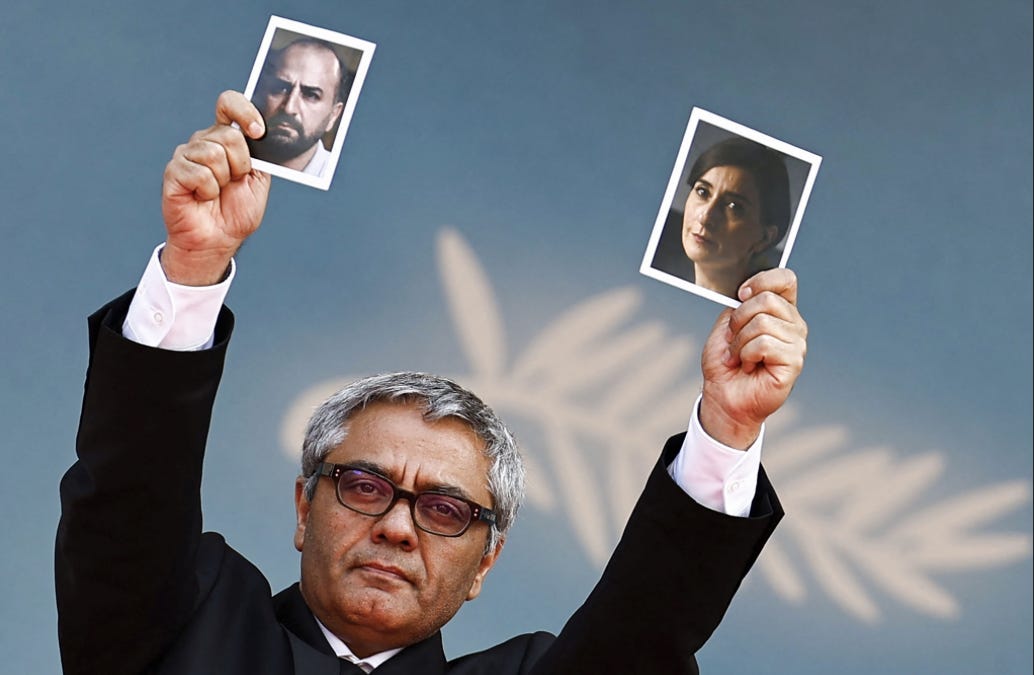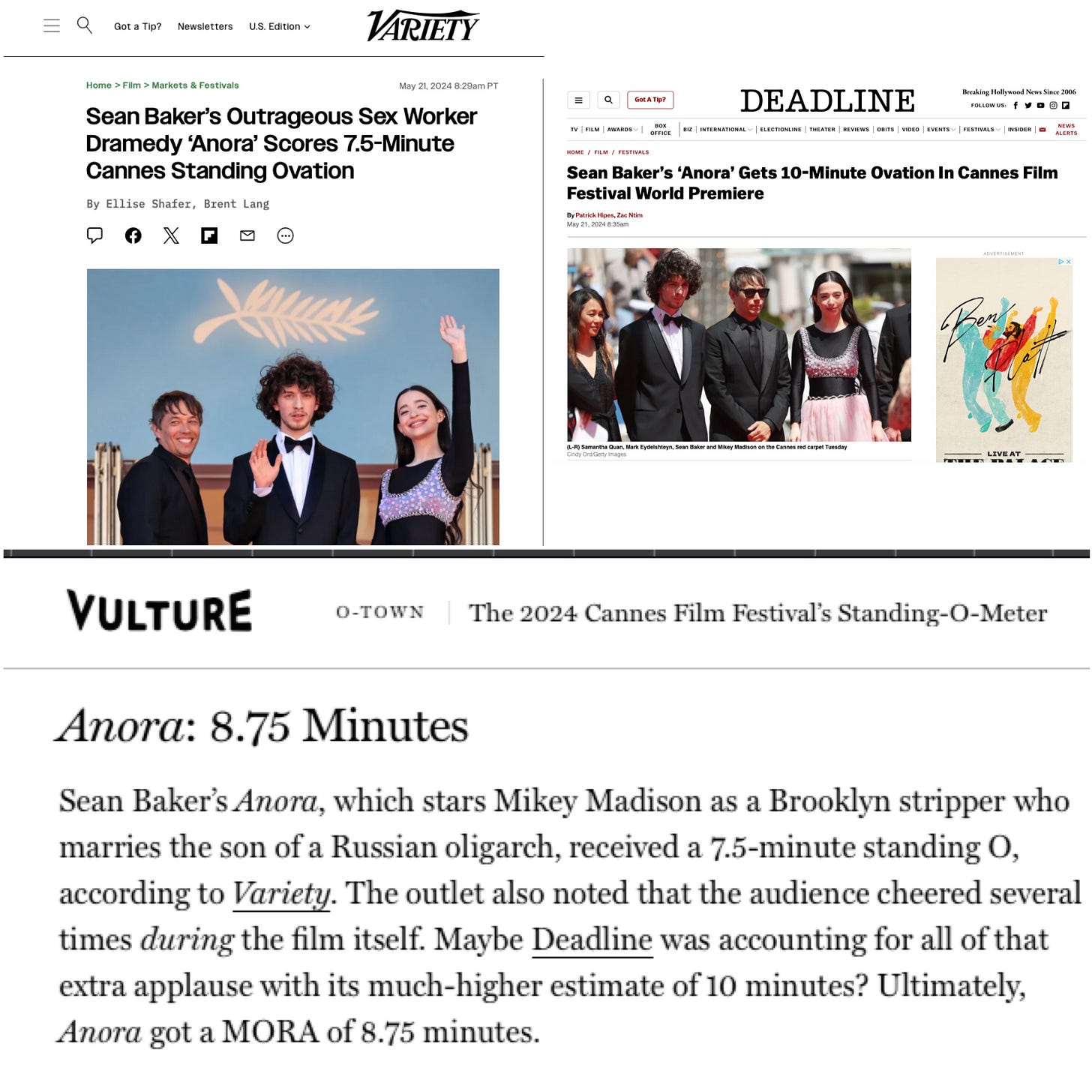Cannes 2024: A Final View From Afar
I Didn't Attend Cannes (Again), But That Didn't Stop Me From Following Along (Again)
A Generational Palme D’Or
Yesterday, in the south of France, the 2024 Cannes Film Festival wrapped up with its annual awards ceremony and Closing Night Film, capping two weeks of screenings and glamour as the festival continued to deliver the spectacle of cinema for onlookers near and far. I was, again, in the latter category, but despite my annual promise to myself to get back to Cannes again soon, I watched along at my desk each day, checking in on the festival’s incredible YouTube feed1 (produced by France TV), which featured all of the red carpets, press conferences, and photo calls for all of the films playing In Competition.
The quality of this production— having a television partner produce and carry these events each and every day of the festival— is a huge balm for those of us stuck back home; the ability to stay up to date with the schedule, the arrivals, the formal business of the festival, in real-time (and in replay), makes the festival feel alive, even when you’re far away. And so, a huge congratulations to the festival team for not only maintaining the festival’s commitment to ensuring that every film in competition is elevated to the status of a formal, black-tie event, but for projecting that elevation around the world in a beautifully produced way that allows anyone with access to YouTube to watch along.
In an era where cinema is constantly being dismissed as an art form and labeled as little more than consumable “content” upon which some stock’s price moves when a company makes or loses money at the Box Office, Cannes’ controversial decision to support theatrical distribution and to continue to demand the veneration of film as an art form looks better and better each year. Long may it continue.
This year, the power of lifting film up in this way was made more personal than ever before, when Greta Gerwig was named President of the festival’s Competition Jury. As I wrote last year, Greta’s ascendancy as an actor, writer, and director felt like the fulfillment of the American independent film community’s investment in a generation of talented artists (a generation that includes a Best Picture win for Barry Jenkins, the rise of the Safdie Brothers, etc.)— so many American film festivals worked to give these artists a platform and the encouragement to continue making great work, to build connections and community with one another, and to build a sustainable path for their early films— For Cannes to elevate Greta as an artist in this way was incredibly meaningful to so many American film programmers, whose work generally goes unrecognized in an industry focused on premieres and sales at three or four major American festivals. But it is the important work of local and regional film non-profits who build the infrastructure for films, who do the grassroots work in countless communities across the country to build audiences, that are the soil from which independent American filmmakers can grow and, it turns out, become Palme D’Or winners.
I first encountered Sean Baker’s work when I was working at IFC in the late 1990’s and I was there for the beginnings of “Greg The Bunny,”2 and that ensured I watched his debut film “Take Out” in 2004, which was a huge shift in style.3 In 2009, I was proud that we were able to bring Sean’s second film “The Prince Of Broadway” to our festival and since then, I, like so many other American film programmers, have been very fortunate to be able to continue to show Sean’s films at my festivals and my cinema, including “Starlet” (2012), “Tangerine” (2015), “The Florida Project” (2017), and “Red Rocket” (2021). Sean’s deeply humanist, moving (and funny) stories of working class life (and sex work in particular), of the struggles to escape the economic and social cycles of poverty, set him apart from every other American filmmaker of this (or any) generation.
When Sean premiered his new film “Anora” in Competition at Cannes to rapturous reviews, my ears perked up, and I sent a text to my programming partner of many years Holly Herrick (now the engine driving the programs at the Austin Film Society) as well as my current partners Larisa Apan and Rebecca Sokol at Montclair Film, joking about how, if Greta Gerwig ended up giving the Palme D’Or to Sean Baker, my 2008 brain might explode4.
Friends, it happened.
Sean Baker was awarded the Palme D’Or at Cannes by a jury lead by Greta Gerwig.
I jumped on social media and saw so many of my friends and colleagues in the industry, people who have worked hard to bring attention to this generation of artists for so many years, celebrating. “Anora”’s Palme win, like Barry Jenkins’ Oscar win for “Moonlight”, has the feeling of a generational moment, the culmination of years of work supporting filmmakers whose works have remained true to their independent vision, a victory for an entire community of distributors, festival and cinema programmers, for the contemporary American independent film community as whole. Obviously, the work speaks for itself— I can’t wait to see “Anora” and I hope we have the opportunity to share it both at our festival and our cinema in Montclair (of course!) — but to have the work of an American independent filmmaker win Cannes again, at this moment in time when the work of independent filmmaking and the community that surrounds it is so fraught, it feels like our generation’s moment has arrived. At last.
Congratulations to Sean Baker, to Neon for supporting his work, to Greta for leading this Jury, and to the team at the Festival De Cannes for what, from afar, appeared to be an excellent year.
Now, to catch up with all of these amazing films…
Mohammad Rasoulof Update
Prior to the start of Cannes, I voiced my support for Mohammad Rasoulof, the Iranian director forced to flee his home country to avoid imprisonment and flogging for his ongoing advocacy for human rights and free expression in Iran. So, I was thrilled to see that Neon (whose team are absolute champions of great films) acquired the rights to bring Rasoulof’s new film “The Seed Of The Sacred Fig” to American screens this fall. Rasoulof is another filmmaker I have admired and worked to support, his prior film “There Is No Evil” won our Montclair Film Festival Competition in 2021, and so I cannot wait to see his new work soon in the hopes of being able to share it with our audiences.
Rasoulof also won an award at Cannes, The FIPRESCI Award, where the jury of the International Federation of Film Critics stated that the film was “a courageous story set in modern-day Iran that deals with the conflict between tradition and progress, depicted in a very powerful and imaginative way.”
But perhaps most important of all, Rasoulof was there, standing proud and unbowed on the red carpet, and was in the cinema for his premiere, able to receive the gratitude of his audience, who gave the film a thunderous ovation. In his hands, he held the photos of his actors Missagh Zareh and Soheila Golestani, both stranded in Iran. It was an incredibly powerful gesture, one that visually articulated both the film’s powerful presence at the festival, but also the aching absence at the heart of the event— yes, Rasoulof was there, but without full, systemic change, the victory is incomplete.
And so, if you are interested in Rasoulof’s work, I urge you to check out his previous films “Manuscripts Don’t Burn” (available for rent on multiple streaming platforms), “ A Man Of Integrity” (available on DVD from Big World Pictures via The Cinema Guild)5, and “There Is No Evil” (also available for rent on multiple streaming platforms) and then please see “The Seed Of The Sacred Fig” when it comes your way.
The work continues— it is up to cinemas and filmgoers to engage with that work and support the change that is required.

Rise of The Influencers
For all of my veneration of Cannes as a festival, it is certainly not perfect, and this year once again highlighted the disparity between the art of cinema and our shifting values in a world driven by the “democratic promise” of social media. First, it goes without saying that the red carpet at Cannes is not a publicly accessible space— screening and premiere attendees are accredited industry, press, sponsors, and talent. But throughout the festival, a cursory glance at any social media feed’s #Cannes2024 hashtag instantly demonstrated the rising importance of social media “influencers” on the Cannes carpet (which, ironically, has a “no selfies” policy.)
And so, people who have built their careers as brand and lifestyle influencers on social media ended up dominating social media feeds and had, in my experience, a diminishing effect on the value of social media as a tool for the films themselves— I found myself scrolling past endless photos and posts driven by influencer “fan accounts” declaring their undying love for a global array of young, beautiful people (almost all women) who were on hand to help promote brands, take pictures by the sea, arrive at events and parties, and walk the red carpet to be photographed. It was work to try to find film reactions and reviews6.
Obviously, the festival has built its identity upon the glamour of having celebrities, dressed to the nines, attending its screenings, private dinners, and special events, and in this very online age, the idea of “celebrity” continues to shift— I am sure that having a new generation of young people promoting the unique experience of a trip to the festival is very much appreciated. And of course, the carpet itself is a massive global opportunity for fashion companies and designers to get their clothing into the consciousness of precisely the people who can afford to buy haute couture. But I will say, there is a new texture to the dissonance between the emerging online culture of fashion, influencers, branding, corporate sponsorship, and social media platforms, and the serious veneration of the global art of cinema at a festival that pushes back against the prioritization of streaming. I’ll be interested to see how this relationship continues to evolve.
The Official Timepiece Of Cannes Ovations
Finally, I’m just going to put this here:
Cannes is missing an opportunity to have their watch sponsor (Chopard, who also make the Palme D’Or trophy itself) become “The Official Timepiece of Cannes Ovations”
It’s simple:
Once the film ends and the applause begin, in the bottom corner of the Palais screen, a Chopard-branded timer pops up on the screen and, once the applause dies down, everyone marks the final posted time as Official. That way, the inaccurate reports of ovation times can, once and for all, be settled with all of the elegant precision you have come to know and expect from Chopard’s legendary timepieces7.
You’re welcome, Cannes. Take this idea from me for free. It is my pleasure to provide fundraising opportunities to the biggest festival in the world.
Kids, don’t forget to smash that “Like” button and subscribe to the channel!
Sean was a co-creator on this show, which was way ahead of its time. Shout out to Alison Palmer, who was this show’s major champion at IFC.
As someone who grew up in a working class community, I deeply admired Sean’s commitment to social realism, and his ongoing exposure of the crushing cycles of trying to get ahead financially in a country that thrives on the limiting powers of debt.
Remember the ending of “Fight Club”? Like that.
Please get this movie (actually, all of them) up on a streaming platform? Looking at you, Criterion Channel! 😘
I persevered, of course! 🤣
Chopard, I am also available to you!








